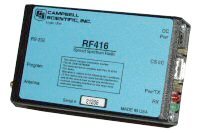
概要
RF416 スペクトラム拡散無線は、汎用ワイヤレス データ通信に使用でき、ポイントツーポイントおよびポイントツーマルチポイントのデータロガー通信をサポートします。データロガーに接続しているときはフィールド モデム/無線として、コンピュータに接続しているときはベース ステーション モデム/無線として機能します。
RF416 の周波数範囲は 2.450~2.482GHz で、世界中の多くの国で使用されています。他の RF416 無線、RF432 無線、CR216(X) データロガーおよび AVW216 インターフェイスの内部無線と通信できます。
注意:この無線モデムの動作周波数帯域は、コードレス電話などの他の非ライセンス サービスや、緊急放送や航空管制などのライセンス サービスと共有される場合があります。
続きを読む利点と特徴
- デバイス間の長距離無線通信
- ライセンスフリーの運用が許可されている多くの国で手間のかからない運用
- 平均消費電力が低い
- Campbell Scientific PakBus ネットワーキング向けに最適化
- 他のサードパーティ ソリューションと比較して、PakBus プロトコルを使用する場合の RF 効率が向上
- 専用の PakBus RF リピータが必要な場合でも低コストのスタンドアロン運用
- 25チャンネルを超える周波数ホップにより、他のスペクトラム拡散無線からの干渉を回避
イメージ

詳細
スペクトラム拡散無線は、通常は狭帯域の情報信号を比較的広い周波数帯域に拡散します。これにより、通信は、ポケットベル、携帯電話、マルチパスなどの RF ソースからのノイズや干渉に対して非常に耐性があります。RF416 は、ユーザーが選択できる周波数ホッピング パターンを提供することで、他のスペクトラム拡散デバイスからの RF 干渉に対する感受性を低減します。
スペクトラム拡散無線は、すべての FCC Part 15 デバイスと同様に、ライセンスされた無線通信に有害な干渉を引き起こすことは許可されておらず、受信した干渉を受け入れる必要があります。 Campbell Scientific のユーザーのほとんどは、干渉の可能性が低いオープンな場所や遠隔地で作業しています。問題がある場合は、デバイスの移動、方向の変更、別の種類のアンテナの使用、RF シールドの追加などの方法で干渉を軽減できます。
無線機への電源供給
ベース ステーションでは、15966 壁面充電器を使用して RF416 に電源が供給されます。現場サイトでは、通常、データロガーから CS I/O ポートを介して RF416 に電源が供給されます。次の状況では、現場サイトで #14291 フィールド ケーブルが必要です。
- 無線機が CS I/O ポートではなくデータロガーの RS-232 ポートに接続されている
- 1997 年 12 月以前に購入されたデータロガー
アンテナ
Campbell Scientific では、この無線機用のさまざまなアンテナを提供しています。16005 は、全方向性 1/2 波長、0 dBd、ホイップ アンテナで、無線機に直接接続され (ケーブルは不要)、短距離(最大 1マイル)を送信できます。 17480 ダイポール アンテナには、窓や壁に取り付けるための接着剤と、無線機に接続するためのケーブルが含まれています。
当社の高ゲイン 30411 全方向性アンテナと 16755 八木アンテナには、無線機に接続するためのケーブルが必要です。31314 サージ プロテクタは、落雷や静電気が蓄積する影響を受けやすい無線機や、トランシーバとアンテナ間のケーブル長が 3m(10フィート)を超える必要がある場合に使用できます。
仕様
| 周波数 | 2.450~2.482GHz |
| 無線タイプ | 周波数ホッピングスペクトラム拡散(FHSS) |
| 使用されている国 | 2.4GHzのWi-Fi通信が許可されている国 |
| 伝送距離 | 全方向性アンテナ(屋外)使用時 0.4 km(0.25 マイル)、理想的な条件下では高利得指向性アンテナ使用時最大 0.8 km(0.5 マイル) |
| RS-232 ボーレート | 38.4k、19.2k、9600、4800、または1200bps |
| チャンネル容量 | 65,000 個のネットワーク識別子が 25 ホップ チャネルを共有します。 |
| 周波数ホッピングパターン | 6種類のパターンから選択可能 |
| 周波数制御 | ダイレクトFM |
| 受信感度 | 10-4 ビット エラー レート で -104 dBm (Campbell Scientific プロトコルは、ビット エラーが発生するたびに再試行を実行します。) |
| 干渉除去 | 70 dB (ポケベルおよび携帯電話の周波数) |
| 出力 | 50 mW (通常) |
| データレート | 10 kbps |
| アンテナコネクタ | 逆極性SMA (RPSMA) |
| RS-232 コネクタ | 9ピンDメス (4線:Tx、Rx、CTS、GND) |
| CS I/Oコネクタ | 9ピンDオス |
| FCC ID | OUR-24Xストリーム |
| 電源 | 9 ~ 16 Vdc |
| 動作温度範囲 | -25° ~ +50°C |
| LED について | 電源オン、TX、RX、診断 |
| 電源コネクタ | バレルプラグ、センタープラス 12 V (14291 フィールド電源ケーブルの接続に使用) |
| 平均電流消費量 |
|
| 通信ポート |
|
| 寸法 | 11.4 x 7.0 x 2.9 cm (4.5 x 2.8 x 1.1 in.) |
| 重量 | 227 g (8 oz) |
互換性
注意: 以下は代表的な互換性情報を示しています。互換性のある製品や互換性のない製品をすべて網羅したリストではありません。
Data Loggers
| 製品 | 互換性 | 注意 |
|---|---|---|
| 21X (リタイア) | ||
| CR10 (リタイア) | ||
| CR1000 (リタイア) | ||
| CR1000X (リタイア) | ||
| CR10X (リタイア) | ||
| CR200X (リタイア) | ||
| CR206X (リタイア) | ||
| CR211X (リタイア) | ||
| CR216X (リタイア) | ||
| CR23X (リタイア) | ||
| CR295X (リタイア) | ||
| CR300 (リタイア) | 18663 ヌルモデムケーブルを使用します。 | |
| CR3000 (リタイア) | ||
| CR350 | 18663 ヌルモデムケーブルを使用します。 | |
| CR500 (リタイア) | ||
| CR5000 (リタイア) | ||
| CR510 (リタイア) | ||
| CR6 | ||
| CR800 (リタイア) | ||
| CR850 (リタイア) | ||
| CR9000 (リタイア) | CR9000 は互換性がありますが、RF416 無線はデータロガーの最速通信速度をサポートしていないため、多くの CR9000 アプリケーションには実用的ではありません。 | |
| CR9000X (リタイア) | CR9000X は互換性がありますが、RF416 無線はデータロガーの最速通信速度をサポートしていないため、多くの CR9000X アプリケーションには実用的ではありません。 |
互換性に関する追加情報
通信
CR216(X) データロガーの内部無線
RF416 スペクトラム拡散無線は、CR216(X) データロガーの内部スペクトラム拡散無線と通信できます。無線とデータロガー間の通信を成功させるには、特定の RF416 設定が CR216(X) 設定と一致している必要があります。これらのデバイスの工場出荷時のデフォルト設定は一致しない可能性があるため、通信を行う前に再設定する必要がある場合があります。詳細については、RF401 から CR206 への通信を設定するためのクイック リファレンス ガイドのアプリケーション ノート (右側のドキュメントを参照) を参照してください。
その他のスペクトラム拡散無線
RF416 無線は、RF432 および RF415 無線を含むネットワークで使用できます。RF415 無線を含むネットワークで RF416 無線を使用する場合は、プロトコルを Transparent に設定する必要があります。また、RF415 無線と RF416 無線が同じ RF 近接性にある場合は、RF415 ネット アドレスに 28、44、52、56、または 60 を使用しないでください。ネット アドレスが 28、44、52、56 の RF415 無線は、ネット アドレスがそれぞれ 0、1、2、3 の RF416 無線と干渉します。RF415 ネット アドレスが 60 の場合、すべての RF416 ネット アドレスと干渉します。
RF416 の 2.4GHz 無線は、周波数の違い(つまり、2400MHz と 900MHz)により、RF450、900MHz ネットワークでの並列操作にも適しています。
Campbell Scientific は、FGR-115 無線を含むネットワークで RF416 を使用することを推奨していません。
Transparent プロトコルと PakBus プロトコル
Transparent プロトコルに設定された RF416 無線と、いずれかの PakBus プロトコルに設定された RF416 または RF432 無線を混在させないでください。混在させると、RF 通信のない RF トラフィックが生成されます。ただし、PakBus Aware 設定と PakBus Node 設定の無線は、同じネットワーク内に共存できます (つまり、一部の無線を PakBus Aware に設定し、一部の無線を PakBus Node に設定できます)。
屋外収納ボックスの考慮事項
乾燥した、結露のない環境が必要です。14162 マウント キットには、RF416 を屋外収納ボックスのバックプレートに固定するためのハードウェアが含まれています (注文情報を参照)。
ドキュメント
テクニカルペーパー
ダウンロード
RF401 Series OS v.04 (646 KB) 14-08-2008
Current RF401, RF411, RF416 firmware. Requires the Device Configuration Utility.
よくある質問
RF416に関するよくある質問の数: 6
すべて展開すべて折りたたむ
-
はい。BMP5 Direct SDK は、次の 2 つの条件が満たされている限り、データロガーと通信できます。
- データロガーとコンピュータ間の通信リンクは透過的です。
- 過度の遅延はありません。
-
RF416 は、真の見通しを必要とする 50 mW、2.45 ~ 2.46 GHz の無線です。乾燥した環境で、見通し経路を妨げる物理的な障害物がまったくなく、適切な高さのアンテナを使用した場合、RF416 の予想範囲は約 5 マイルです。
-
これらの無線機には、SC12 シリアル ケーブルと 10873 RS-232 ケーブルが付属しています。
-
アンテナの選択は複数の基準によって決まります。
- 特定のステーションが通信する必要があるステーションの数を考慮してください。 1 つのリピーターまたはベース ステーションとのみ通信するリモート ステーションの場合、指向性アンテナまたは八木アンテナが適切な選択肢となる可能性があります。 対照的に、さまざまな場所からデータを受信するリピーター ステーションでは、全方向性アンテナが必要になる可能性があります。
- 2 点間の経路を越えるには高利得アンテナが必要かどうかを検討してください。高利得アンテナはより大きく、より高価になります。
アンテナの選択と設置場所の配置を支援するために、デモ キットをレンタルして使用し、経路の品質をテストすることを検討してください。Campbell Scientific は、RF401、RF430、CR206X、AVW206 用の 900 MHz デモ キットと、RF450 用のデモ キットを提供しています。サポートについては、Campbell Scientific にお問い合わせください。
記事とプレスリリース
Privacy Policy Update
We've updated our privacy policy. 詳細はこちら
Cookie Consent
Update your cookie preferences. クッキーの設定を更新する


